PRODUCTS
UVSIS TM : Ultraviolet Skin Imaging System
A recent video by Thomas Leveritt of New York called How the Sun Sees You has stimulated a great deal of interest in UV skin imaging. In response to numerous customer inquiries, Oculus introduces the Ultraviolet Skin Imaging System, or UVSIS™, a “UV Mirror” that allows people and their skin care professionals to assess sun damage of facial skin and to practice proper application of sunscreen.
See Video and Images made by UVSIS
A person sits or stands facing the video display and can see their own face imaged in the ultraviolet spectrum of light with live video, as though they were looking into a mirror. Skin wrinkles, dry patches and especially hyperpigmentation (freckling) are highly accentuated. Normally transparent sunscreen appears very dark, like black paint, making it very easy to see if spots have been missed during application, particularly on and around the ears.
UVSIS consists of an Oculus Photonics ultraviolet camera module mounted on top of a 17 inch video display. Illumination is provided by two UV LED gooseneck lamps on either side of the display. The lamps can be adjusted for optimal illumination on different sized faces. The results are very similar to the look of the UV video in How the Sun Sees You. In the UVSIS system, the UV camera is equipped with a 22 degree lens, which is ideal for imaging a person’s face at a 3 foot distance.
UVSIS system uses proprietary UV imaging technology to eliminate visible and infrared contamination of the UV image in daylight and interior lighting conditions. UV radiation is almost completely absent in the indoor environment , requiring both specialized UV illlumination and an immunity to non-UV light. UVSIS uses spectrally pure UV illumination from LEDs, eliminating chromatic aberration effects in the optics and giving a crisp UV image.
UVSIS Specs at a Glance
SpectraScanner TM
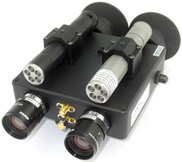 The SpectraScanner is the latest product from Oculus Photonics, released in July 2012. The SpectraScanner is a handheld imaging system that has all the functionality of the UVScanner, plus an additional near-infrared viewing capability. This dual-band imager uses two separate cameras, one tuned for longwave ultraviolet, the other for near-infrared. The operator toggles a selector switch on the top of the unit to change bands. As with the UVScanner, the SpectraScanner is not a recording device, but it does have an auxiliary SMA output that can be used to attach it to a recording device such as a DVR, or an external monitor. The SpectraScanner is the latest product from Oculus Photonics, released in July 2012. The SpectraScanner is a handheld imaging system that has all the functionality of the UVScanner, plus an additional near-infrared viewing capability. This dual-band imager uses two separate cameras, one tuned for longwave ultraviolet, the other for near-infrared. The operator toggles a selector switch on the top of the unit to change bands. As with the UVScanner, the SpectraScanner is not a recording device, but it does have an auxiliary SMA output that can be used to attach it to a recording device such as a DVR, or an external monitor.
The SpectraScanner is equipped with a 396nm longwave UV LED flashlight and a 830nm near-IR flashlight for scene illumination in the two wavebands. The useful range of the longwave-UV flashlight is approximately 10 feet for a typical scene with 40% longwave-UV reflectivity. The near-IR flashlight can illuminate scenes up to about 50 foot range, and the SpectraScanner can be used as a covert night vision device in the near-IR mode. The eyecups on the back of the SpectraScanner are designed to close off when the device is not pressed against the face. This keeps dust off the display lenses and also prevents light from the displays from illuminating the room when the SpectraScanner is momentarily not in use but is still powered on.
See also:
Click on thumbnails for views of the SpectraScanner:
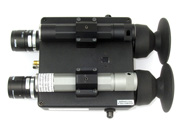 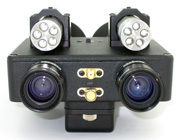
UVScanner TM
 The UVScanner is a handheld imaging system that is more rugged and man-portable than the UVCorder and is designed for greater ease of use if the goal is to scan a scene in the near-UV band. The UVScanner is not a recording device, but it does have an auxiliary SMA output that can be used to attach it to a recording device such as a DVR, or an external monitor. The UVScanner is equipped with two 396nm LED flashlights for scene illumination. The useful range of the flashlights is approximately 10 feet for a typical scene with 40% near-UV reflectivity. The eyecups on the back of the UVScanner are designed to close off when the device is not pressed against the face. This keeps dust off the display lenses and also prevents light from the displays from illuminating the room when the UVScanner is momentarily not in use but is still powered on. The UVScanner is a handheld imaging system that is more rugged and man-portable than the UVCorder and is designed for greater ease of use if the goal is to scan a scene in the near-UV band. The UVScanner is not a recording device, but it does have an auxiliary SMA output that can be used to attach it to a recording device such as a DVR, or an external monitor. The UVScanner is equipped with two 396nm LED flashlights for scene illumination. The useful range of the flashlights is approximately 10 feet for a typical scene with 40% near-UV reflectivity. The eyecups on the back of the UVScanner are designed to close off when the device is not pressed against the face. This keeps dust off the display lenses and also prevents light from the displays from illuminating the room when the UVScanner is momentarily not in use but is still powered on.
See also:
Click on thumbnails for views of the UVScanner:
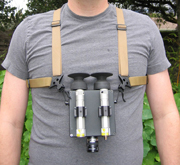 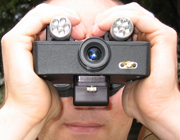 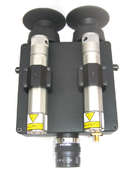
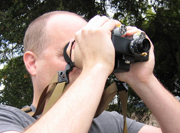 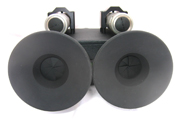 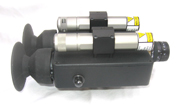
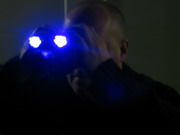
UVCorder TM
Click on thumbnail for larger view of UVCorder
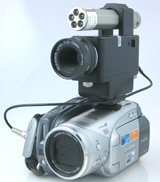 The UVCorder™ consists of a Canon Vixia Camcorder equipped with the Canon advanced accessory shoe, upon which is mounted a special ultraviolet camera module, or UVM. The shoe provides a mounting base for the UVM, which plugs into the shoe much like an accessory light or flash unit. The UVM is powered by its own lithium ion battery. The UVM contains a silicon CCD camera with enhanced ultraviolet response in the 300-400nm range, and a peak response at 370nm. A special filter rejects both visible and infrared light from reaching the sensor. This means that the UVCorder™ can be used in situations where the ultraviolet illumination is lower than the visible or infrared illumination. For example, on a clear, sunny day, the UV images formed by the camera are 99% ultraviolet in their spectral content. A standard black light can be used in indoor situations, since by design most interior lighting emits little UV light. The UVCorder™ consists of a Canon Vixia Camcorder equipped with the Canon advanced accessory shoe, upon which is mounted a special ultraviolet camera module, or UVM. The shoe provides a mounting base for the UVM, which plugs into the shoe much like an accessory light or flash unit. The UVM is powered by its own lithium ion battery. The UVM contains a silicon CCD camera with enhanced ultraviolet response in the 300-400nm range, and a peak response at 370nm. A special filter rejects both visible and infrared light from reaching the sensor. This means that the UVCorder™ can be used in situations where the ultraviolet illumination is lower than the visible or infrared illumination. For example, on a clear, sunny day, the UV images formed by the camera are 99% ultraviolet in their spectral content. A standard black light can be used in indoor situations, since by design most interior lighting emits little UV light.
Live images from the color video camera and the UVM are displayed on a 2.7 ” LCD screen on the camcorder. UV video can be recorded to a 60 minute mini-DV cassette tape.
The UVcorder™ will run for about 2 hours on the lithium battery included with the system. Total system weight is 880 grams, or about two pounds, not including the rugged, watertight carrying case that comes standard with the system.
The UVM accepts C-mount lenses that have UV transmission. The UVCorder comes standard with a 16mm focal length uncoated glass lens designed for machine vision camera applications that has good UV transmission. The lens has an adjustable iris that ranges from f/1.4 to f/16 and then to fully closed. Other focal length lenses are available.
See also:
|


